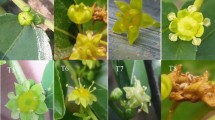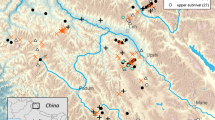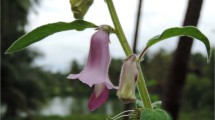Abstract
THE method of seed dispersal in the annual glasswort Salicornia pusilla (Chenopodiaceae), a local plant of coastal salt-marshes, is of interest. In this species the seeds are deeply immersed in the fleshy tissues of the stem cortex, and are covered (except at the minute orifice) by the long persistent perianth. In all other European species of this genus, the inflorescence consists of decussately paired 3-flowered cymules. In S. pusilla, however, these cymules are single flowered. A normal fruiting head (Fig. 1) contains 4–10 seeds and is shed from the parent plant, as the seeds ripen, by the development of an abscission layer. The seeds are retained within the cortical tissues even when the fruiting head has become separated.
This is a preview of subscription content, access via your institution
Access options
Subscribe to this journal
Receive 51 print issues and online access
$199.00 per year
only $3.90 per issue
Buy this article
- Purchase on Springer Link
- Instant access to full article PDF
Prices may be subject to local taxes which are calculated during checkout
Similar content being viewed by others
Author information
Authors and Affiliations
Rights and permissions
About this article
Cite this article
DALBY, D. Seed Dispersal in Salicornia pusilla. Nature 199, 197–198 (1963). https://doi.org/10.1038/199197a0
Issue Date:
DOI: https://doi.org/10.1038/199197a0
This article is cited by
-
Phylogenetic and morphological studies of Sarcocornia (L.) A.J. Scott and Salicornia L. (Chenopodiaceae) and insights into plant diversity with first record of two species new for Tunisia
Genetic Resources and Crop Evolution (2022)
-
Investigating gall midges (Asphondylia), associated microfungi and parasitoids in some chenopod plant hosts (Amaranthaceae) in south-eastern Australia
Arthropod-Plant Interactions (2021)
-
Factors affecting the success of early salt-marsh colonizers: seed availability rather than site suitability and dispersal traits
Plant Ecology (2010)
-
Population biology of salt marsh and sand dune annuals
Vegetatio (1985)
-
Halophyte seed germination
The Botanical Review (1978)
Comments
By submitting a comment you agree to abide by our Terms and Community Guidelines. If you find something abusive or that does not comply with our terms or guidelines please flag it as inappropriate.



